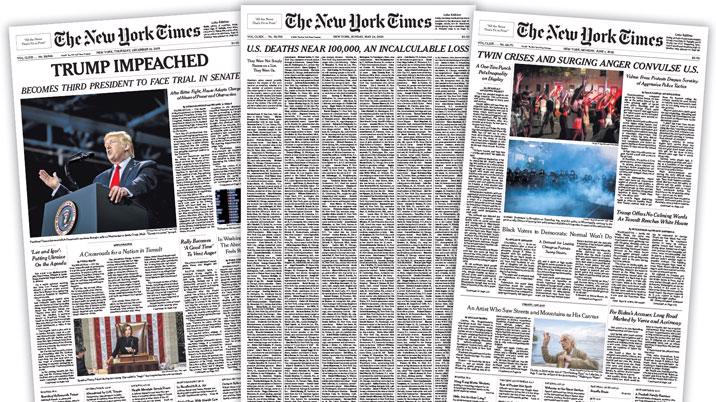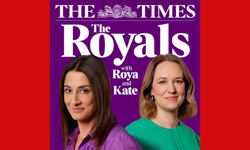
It is difficult now to remember just how surprising the appointment of the outgoing director-general of the BBC, Mark Thompson, as chief executive of the New York Times really was at the time.
What?
A famous old newspaper which some feared might be in terminal decline had hitched its commercial fate to someone whose career was in broadcast journalism with absolutely no experience of newspapers, let alone running them.
Thompson, who had also run Channel 4, thought the 2012 call was just a head-hunter thing – add a left-field name to spice up the candidates list.
The New York Times, however, had an ambition to become a global news provider, and was convinced “that the actual institutional changes we had made at the BBC, and to some extent at Channel 4, to get a big organisation focused on the future, was something I could help them with.”
Far from being resistant to change, the New York Times staff were full of pent up ideas and raring to go.
New direction needed
As the then New York Times publisher Arthur Ochs Sulzberger explained, the one thing the New York Times knew about was newspapers, but they needed help with the coming digital transformation and developing new directions.
Even then, it was hardly a done deal because many warned Thompson not to take the job because the newspaper industry was facing a slow lingering death, and although the New York Times was stronger than most, it was still only a matter of time. And, clever as the paper’s journalists undoubtedly were, would they ever accept change?

That was not how Thompson, who confesses to “a soft spot for great media legacy brands,” saw it.
As someone who had run a global news brand in the BBC, Thompson believed the New York Times was unleveraged and underexploited and the exact opposite of doomed.
“There aren’t many truly global news brands in the world. I thought the Times could be another of those and they are incredibly hard to create from scratch,” says Thompson.
There was another small hurdle to overcome – the suspicion of some Times journalists who saw this “strange Brit” as a sort of Bond villain brought in to second guess the editors.
“I am eight years into it now and I don’t think anyone thinks I have the slightest ambition to tell the editor of the New York Times what to put on the front page. They are very good at what they do,” he says.
What Thompson, now heading for 65, has done in those eight years is preside over a remarkable digital transformation. Far from being “the failing New York Times” as President Trump regularly describes the paper, the company had undergone an unprecedented period of growth.
In the first quarter this year, the paper hit, a year early, a target of lifting digital revenues to $800 million a year compared with $400 million in 2014.
In 2012, there were around 500,000 digital subscribers but the rate of increase had been slowing to around 40,000 new subscribers a quarter.
Last year, when the total stood at 5 million, Thompson set a new target of 10 million digital subscribers by 2025 – typically without consulting anyone in advance.
“Everyone said that’s crazy – no newspaper has ever got to 10 million subscribers. We were at 6 million by the end of the first quarter of 2020 and at the current trajectory, we will also hit that target early,” the Times chief executive forecasts.
50 per cent of the staff are millennials – working in tight little teams taking their own decisions and allowed to get on with experiments.
Cultural shift
What, apart from setting apparently impossible revenue and subscription targets, has Thompson and the New York Times staff done to double the share price and with it the market capitalisation of the company, now larger even than the considerably larger News Corporation in eight years?
There were many factors involved in “cracking the code” of building subscriber numbers, not least the fact that, far from being resistant to change, the New York Times staff were full of pent up ideas and raring to go.
An essential first step was to break down the separate silos of newsroom, advertising sales, technology, printing, distribution, subscription and circulation and begin a conversation about how the organisation was going to change and what the strategy should be.
“The different tribes didn’t talk to each other and didn’t collaborate much and that just doesn’t work in digital,” insists Thompson who believes most legacy media organisations are going backwards because they haven’t got the muscle memory on how to work fluidly and flexibly together.
The Times executive once thought you set strategy from the top and then tried to persuade everyone to implement it.
Now he believes you have to cajole staff to come up with their own strategy and then it becomes much easier to implement rather than facing a battle of wills.
Another part of the trick has been “coordinating really deep audience insight with brilliant journalism but also very effective packaging of that journalism into digital experiences where you use testing platforms to try lots of different things.”
Apart from online news, there are spinoffs such as New York Times Cooking and Crossword, designed for all kinds of puzzlers.
For Thompson, it’s also been about “smashing assumptions about seniority” and many of the decisions at the company are now taken by people in their 20s and 30s – 50 per cent of the staff are millennials – working in tight little teams taking their own decisions and allowed to get on with experiments.
I see no reasons why European titles couldn’t also be taking more advantage of this incredibly intense news cycle.
Valuable mistakes
“The role of senior leaders like me is more to provide context, obviously to provide checks and balances if things go too far but essentially to preside and let these teams figure it out,” he explains.
Thompson insists he doesn’t think he deserves much credit other than instilling the belief that staff can take the risk of screwing some things up.
“We have made plenty of mistakes and I think we have done better than many other publishers because we have made more mistakes than they have; they haven’t allowed themselves to make more mistakes,” he adds.
Thompson believes another problem for the newspaper industry is low expectations, a real defeatism about what is possible and a negativity about convincing people to pay for news.
“If you don’t believe people want to buy shoes don’t become a cobbler,” he notes.
The Times executive acknowledges that huge stories such as Trump and the Covid-19 pandemic have helped by creating an increased desire for reliable information but gets irritated at those who say that the New York Times was always a special case and certain to succeed.
They were not saying that at the time.
“I see no reasons why European titles couldn’t also be taking more advantage of this incredibly intense news cycle. I accept their markets are smaller but I think it’s a lack of rigour in terms of how they invest and a lack of belief in journalism,” Thompson argues.
Large and sustained investment is essential and the New York Times typically hires around 100 additional software engineers a year while at the same time continuing to hire for the newsroom.
“We believe in journalism. We need more journalism, more investigative journalism, more features, more lifestyle coverage, more international coverage. Our view is, you invest and get the money back through subscription and you build your subscriptions and it’s a bit like an annuity,” Thompson suggests.
Our view is, you invest and get the money back through subscription.
Print’s days numbered
Print is still important and profitable for the New York Times with just under 1 million print sales, accounting for around 24 per cent of advertising revenue but declining as a proportion of the whole.
He sees print as just another platform alongside online, smart phones, podcasts and TV.
The challenge, Thompson believes, is to grow digital revenues faster than print is declining and if you can’t do that, you are not going to make it.
“Print is a mature platform and my expectation is that long after I have left the Times, it’s going to get switched off. The economics are going to go south and it will be switched off. For us, that is 10 probably 15 years in the future,” says Thompson.
He also believes that the big social media platforms such as Google, Facebook and Twitter, under increasing pressure from governments and regulators, have become more responsive in recent years.
He hopes that win-win commercial relationships, which properly reflect the intellectual property created by organisations like the New York Times, can be created but is wary of government involvement in the process at a time when politicians around the world are trying to get greater control over what people see and hear.
“Giving potentially very large American corporations and national regulators and politicians control over a critical part of the funding of news is really dangerous unless you come up with solutions such as the setting up of arm’s length institutions,” Thompson warns.
The Anglo-Irish former BBC director-general whose mother came from Donegal, still takes a keen interest in the affairs of the BBC and says he is delighted by the appointment of Tim Davie as next director-general.
“I hired him from PepsiCo and he seems to be the right person at the right time,” says Thompson who believes that post-Covid, some of the political threat to the BBC has eased and, that, however grudgingly, politicians might see the BBC as part of the national rebuilding process.
The greatest challenge will be audiences and finding “a fresh logic and a fresh future” to attract the under 60s and perhaps in the longer term, just as the New York Times is envisaging a medium term future without print, so the BBC and other commercial broadcasters may have to imagine a future without traditional broadcasting and mature platforms such as radio and television.
Will the BBC survive as a universal broadcaster funded by a universal mechanism such as a licence fee?
“It should survive because it is needed. Who else is going to give what local radio gives or the Proms, so it should do but you only earn the right to ask for it, if you can prove you can be of universal value,” concludes Mark Thompson, dual citizen of the UK and the US and president and chief executive of the New York Times Company speaking over a weekend from rural Maine.
This article was first published in InPublishing magazine. If you would like to be added to the free mailing list, please register here.












